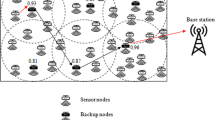Abstract
In this paper, we present a hill-jump algorithm of the Hopfield neural network for the shortest path problem in communication networks, where the goal is to find the shortest path from a starting node to an ending node. The method is intended to provide a near-optimum parallel algorithm for solving the shortest path problem. To do this, first the method uses the Hopfield neural network to get a path. Because the neural network always falls into a local minimum, the found path is usually not a shortest path. To search the shortest path, the method then helps the neural network jump from local minima of energy function by using another neural network built from a part of energy function of the problem. The method is tested through simulating some randomly generated communication networks, with the simulation results showing that the solution found by the proposed method is superior to that of the best existing neural network based algorithm.
Similar content being viewed by others
References
Adamatzky AI (1996) Computation of shortest path in cellular automata. Math Comput Model 23(4): 105–113
Ali M, Kamoum F (1993) Neural networks for shortest path computation and routing in computer networks. IEEE Trans Neural Netw 4: 941–954
Antonio JK, Huang GM, Tsai WK (1992) A fast distributed shortest path algorithm for a class of hierarchically clustered data networks. IEEE Trans Comput 41: 710–724
Baransel C, Dobosiewiez W, Gburzynski P (1995) Routing in multihop packet switching networks: Gb/s challenge. IEEE Net 9(3): 38–61
Bertsekas DP, Gafni E, Gallager RG (1984) Second-derivative routing algorithms for minimum delay distributed routing in networks. IEEE Trans Commum 32: 911–919
Bodin L, Golden BL, Assad A, Ball M (1983) Routing and scheduling of vehicles and crews: the state of the art. Comput Oper Res 10(2): 63–211
Claudio M, Rocco S, Moreno J (2002) Network reliability assessment using a cellular automata approach. Reliab Eng Syst Saf 78(3): 289–295
Cantor DG, Gerla M (1974) Optimal routing in a packet-switched computer network. IEEE Trans Comp 23: 1062–1069
Dijkstra EN (1959) A note on two problems in connection with graphs. Numer Math 1: 261–271
Ephremides A, Verdu S (1989) Control and optimization methods in communication network problems. IEEE Trans Automat Contr 34: 930–942
Frand H, Chou W (1971) Routing in computer networks. Network 1(2): 99–122
Fratta L, Gerla M, Kleinrock L (1973) The flow deviation method: an approach to store-and-forward communication network design. Networks 3: 97–133
Gallager R (1977) Minimum delay routing algorithm using distributed computation. IEEE Trans Commum 25: 73–85
Hopfield JJ (1984) Neurons with graded response have collective computational properties like those of two-state neurons. Proc Natl Acad Sci 81: 3088–3092
Hopfield JJ, Tank DW (1985) ‘Neural’ computation of decisions in optimization problems. Bio Cybern 52: 141–152
Jun S, shin KG (1991) shortest path algorithm path planning in distributed workspace using dominance relation. IEEE Trans Robot Aotomat 7: 342–350
Kwok T, Smith KA (2004) A noisy self-organizing neural network with bifurcation dynamics for combinatorial optimization. IEEE Trans Neural Netw 15: 84–98
Marbach P, Mihatsch O, Tsitsiklis JN (2000) Call admission control and routing in integrated service networks using neuron-dynamic programming. IEEE J Selec Areas Commun 18(2): 197–208
Park YK, Lee G (1995) Application of neural networks in high-speed communication networks. IEEE Commun Mag 33(10): 68–74
Salcedo-Sanz S, Santiago-Mozos R, Bousono-Calzon C (2004) A hybrid Hopfield network-simulated annealing approach for frequency assignment in satellite communications systems. IEEE Trans Syst Man Cybern Part B 34: 1108–1116
Topkis DM (1988) A k shortest path algorithm for adaptive routing in communication networks. IEEE Trans Commun 36: 855–859
Venkataram P, Ghosal S, Kumar BP (2002) Neural network based optimal routing algorithm for communication networks. Neural Netw 15: 1289–1298
Wang J (1996) A recurrent neural network for solving the shortest path problem. IEEE Trans Circuits Syst-1 Fundam Theor Appl 43(6): 482–486
Wang Z, Browning DW (1991) An optimal distributed routing algorithm. IEEE Trans Commum 39: 1379–1387
Wang CJ, Weisseler PN (1995) The use of artificial neural networks for optimal message routing. IEEE Netw 16–24
Wang LP, Li S, Tian FY, Fu XJ (2004) A noisy chaotic neural network for solving combinatorial optimization problems: stochastic chaotic simulated annealing. IEEE Trans Syst Man Cybern Part B Cybern 34: 2119–2125
Yaged BJ (1973) Minimum cost routing for dynamic network models. Networks 3: 193–224
Author information
Authors and Affiliations
Corresponding author
Rights and permissions
About this article
Cite this article
Wang, RL., Guo, SS. & Okazaki, K. A hill-jump algorithm of Hopfield neural network for shortest path problem in communication network. Soft Comput 13, 551–558 (2009). https://doi.org/10.1007/s00500-008-0313-0
Published:
Issue Date:
DOI: https://doi.org/10.1007/s00500-008-0313-0




